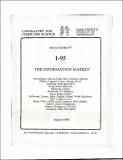Browsing Computer Science and Artificial Intelligence Lab (CSAIL) by Title
Now showing items 1558-1577 of 3804
-
I-95 The Information Market
(1993-08) -
I/O Automata: A Model for Discrete Event Systems
(1988-03) -
I/O Automaton Models and Proofs for Shared-Key Communication Systems
(1999-08)The combination of two security protocols, a simple shared-key communication protocol and the Diffie-Hellman key distribution protocol, is modeled formally and proved correct. The modeling is based on the I/O automaton ... -
I/O Test
(1967-10-01)IO TEST is intended as a hardware testing and debugging aid for use with the PDP-6 and its associated input multiplexer (analog to digital converter) and output multiplexer (digital to analog converter). While all characters ... -
iBCM: Interactive Bayesian Case Model Empowering Humans via Intuitive Interaction
(2015-04-01)Clustering methods optimize the partitioning of data points with respect to an internal metric, such as likelihood, in order to approximate the goodness of clustering. However, this internal metric does not necessarily ... -
ID World: An Environment for the Development of a Dataflow Programs Written in ID
(1986-05)The ID WORLD involves the interfacing of a compiler, interpreter, debugger and editor mode to create an environment for the development of dataflow programs written in ID. It replaces the Tagged-Token Dataflow Architecture ... -
Ideas About Management of LISP Data Bases
(1975-05-01)The paper advocates the need for systems which support maintenance of LISP-type data bases, and describes an experimental system of this kind, call DABA. In this system, a description of the data base's structure is ... -
Ideas About Management of LISP Data Bases
(MIT Artificial Intelligence Laboratory, 1975-01)The trend toward larger data bases in A.I. programs makes it desirable to provide program support for the activity of building and maintaining LISP data bases. Many techniques can be drawn from present and proposed systems ... -
IDEME: A DBMS of Methods
(MIT Artificial Intelligence Laboratory, 1985-08)In this paper, an intelligent database management system (DBMS) called IDEME is presented. IDEME is a program that takes as input a task specification and finds a set of methods potentially relevant to solving that task. ... -
Identifying and Merging Related Bibliographic Records
(1996-02)Bibliographic records freely available on the Internet can be used to construct a high-quality, digital finding aid that provides the ability to discover paper and electronic documents. The key challenge to providing ... -
Identifying Expression Fingerprints using Linguistic Information
(2005-11-18)This thesis presents a technology to complement taxation-based policy proposals aimed at addressing the digital copyright problem. Theapproach presented facilitates identification of intellectual propertyusing expression ... -
Ignorable Information in Multi-Agent Scenarios
(2008-05-12)In some multi-agent scenarios, identifying observations that an agent can safely ignore reduces exponentially the size of the agent's strategy space and hence the time required to find a Nash equilibrium. We consider games ... -
iJam: Jamming Oneself for Secure Wireless Communication
(2010-06-07)Wireless is inherently less secure than wired networks because of its broadcast nature. Attacks that simply snoop on the wireless medium successfully defeat the security of even 802.11 networks using the most recent security ... -
Ill-Posed Problems and Regularization Analysis in Early Vision
(1984-04-01)One of the best definitions of early vision is that it is inverse optics --- a set of computational problems that both machines and biological organisms have to solve. While in classical optics the problem is to determine ... -
Ill-Posed Problems in Early Vision
(1987-05-01)The first processing stage in computational vision, also called early vision, consists in decoding 2D images in terms of properties of 3D surfaces. Early vision includes problems such as the recovery of motion and ... -
Image Based Rendering Using Algebraic Techniques
(1996-11-01)This paper presents an image-based rendering system using algebraic relations between different views of an object. The system uses pictures of an object taken from known positions. Given three such images it can ... -
Image Chunking: Defining Spatial Building Blocks for Scene Analysis
(1987-08-01)Rapid judgments about the properties and spatial relations of objects are the crux of visually guided interaction with the world. Vision begins, however, with essentially pointwise representations of the scene, such ... -
The Image Dissector "Eyes"
(1969-08-01)This is a collection of data on the construction operation and performance of the two image dissector cameras. Some of this data is useful in deciding whether certain shortcomings are significant for a given application ... -
Image Intensity Understanding
(1975-08-01)Image intensities have been processed traditionally without much regard to how they arise. Typically they are used only to segment an image into regions or to find edge-fragments. Image intensities do carry a great ... -
The Image Irradiance Equation: Its Solution and Application
(1981-06-01)How much information about the shape of an object can be inferred from its image? In particular, can the shape of an object be reconstructed by measuring the light it reflects from points on its surface? These questions ...



















